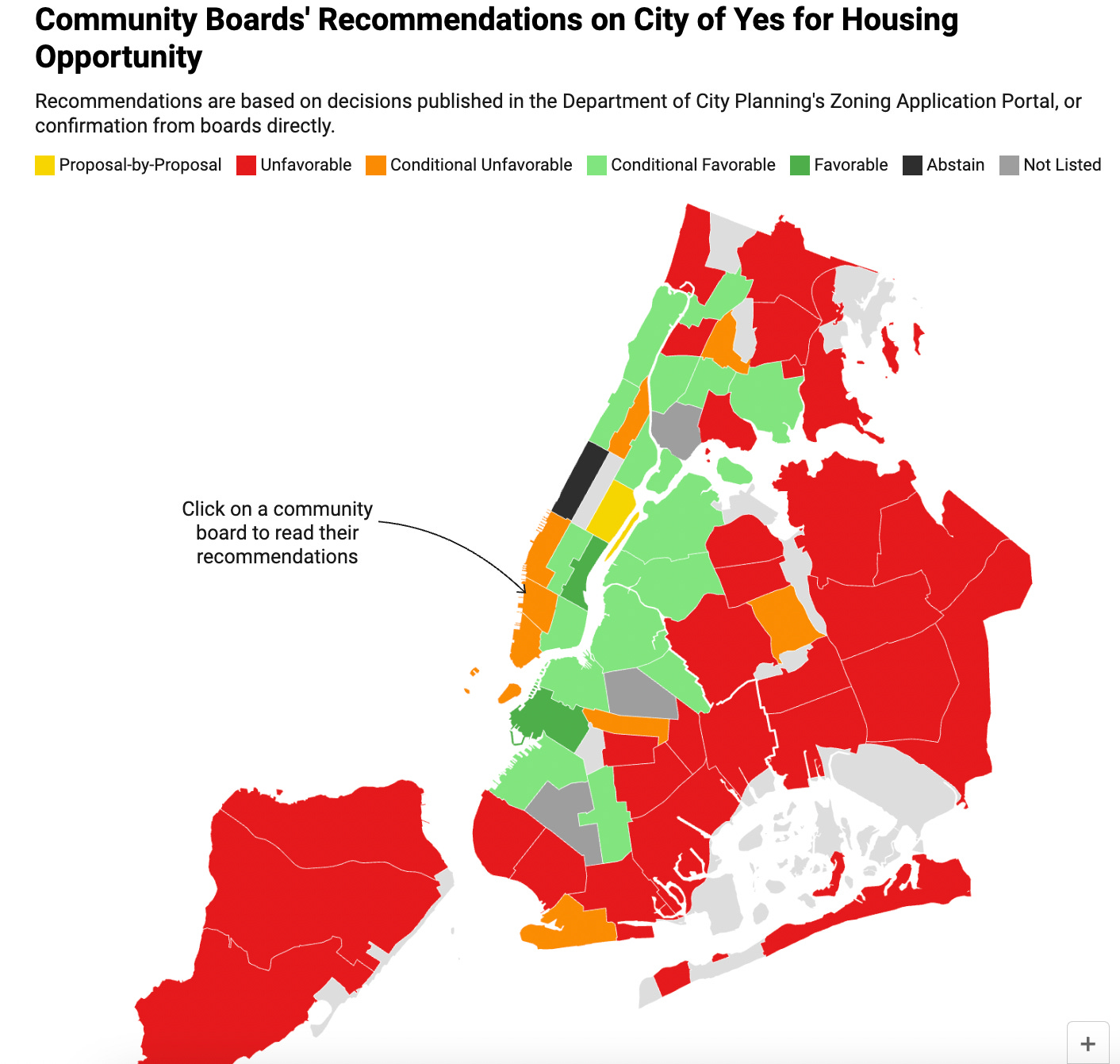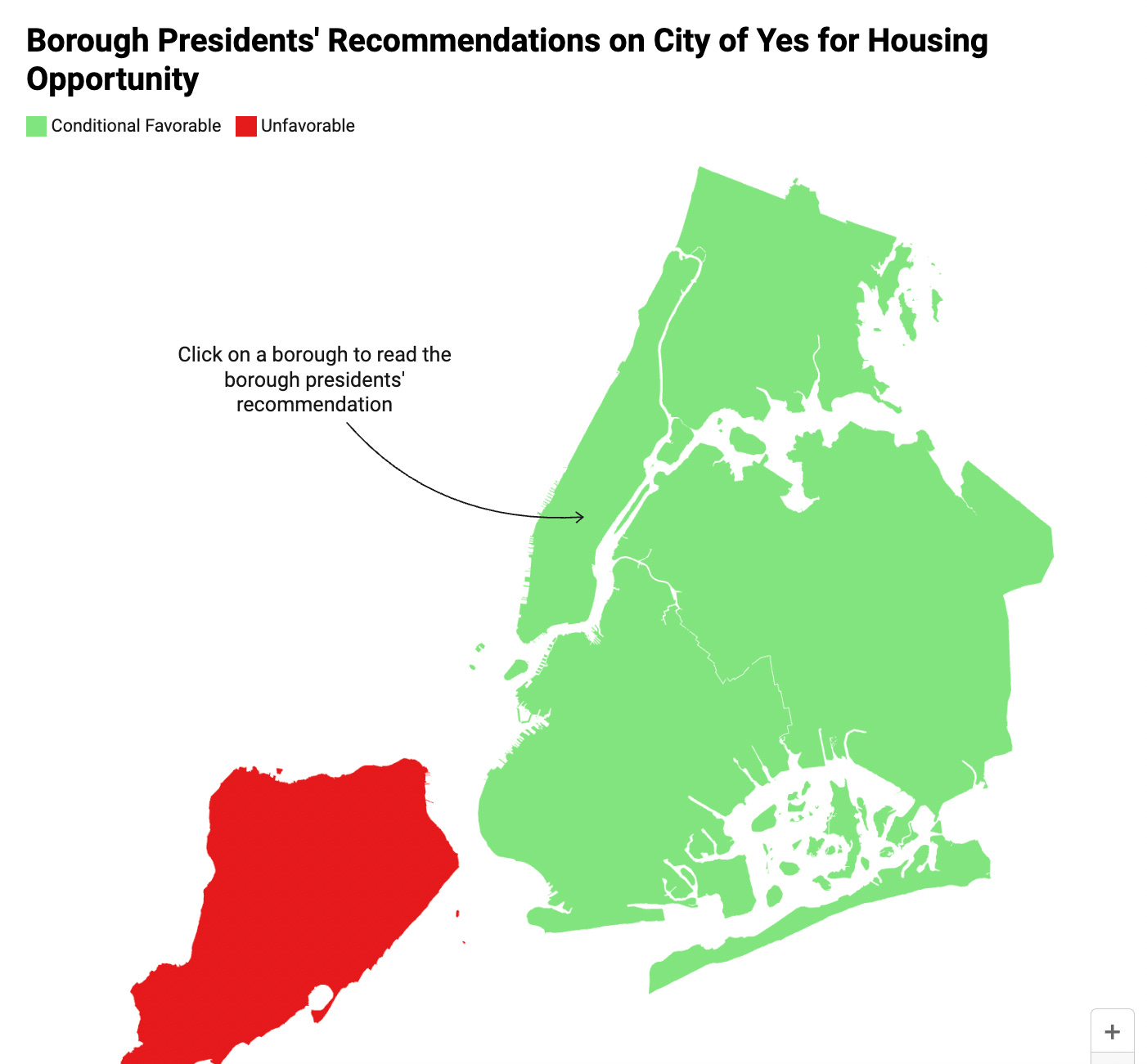What is City of Yes, why is it a big deal, and what is happening?
What Is It?
City of Yes is a massive, overarching plan that changes zoning and approval laws for new development, in an attempt to incentivize/streamline the creation of new housing.

And I mean MASSIVE. This guide by NY Gov is 44 pages long, but I recommend taking a look at it if you’re curious. It digs much deeper than I am going to in this post.
At its heart, COY changes zoning and relaxes the restrictions that make building new housing slow or infeasible, increasing speed of approval and the total allowable size for new projects or additions (by ~20%). Again, this is a massive oversimplification, but per the gov site:
City of Yes for Housing Opportunity is a zoning reform proposal that would address the housing crisis by making it possible to build a little more housing in every neighborhood. If every neighborhood contributes, we can make a big impact citywide without burdening any one area.
Put a pin in that “in every neighborhood,” because we will come back to it.
City Limits goes a bit more in depth with their explanation:
“Unlike neighborhood-based rezonings, City of Yes for Housing doesn’t change any local zoning designations, instead making changes to the zoning code itself to boost potential housing production citywide. It would make it easier to build accessory dwelling units, shared housing models, office-to-residential conversions and infill buildings on educational or religious campuses.
It would allow apartments to be built above stores in low-density areas where that has since been prohibited, and for the construction of larger buildings—ranging three to five stories—near transit hubs. The plan would also do away with minimum parking requirements for new development, and offer a 20 percent density bonus for developers in certain neighborhoods, as long as the extra housing is income-restricted.”
It amazes me that Manhattan has parking minimums for new development. And I support all of these changes at face value, as do people I respect in construction and tenant advocacy (the combination of which is a good sign). Again, no legislation is perfect, and this doesn’t dig into the fine print, but it’s heading in the right direction.
Where Are We?
After a summer of extremely normal not-at-all-racist NIMBY feedback at Community Board meetings, the City Planning Commission voted 10-3 to approve COY and send it to City Council for public feedback, adjustments, and a final vote.
The City Council planned (or possibly still plans) to bring it to a vote before the end of the year, and all signs point to it passing.
A new hiccup is that Adams and much of his government have been indicted and/or resigned and/or searched by the FBI. Certain NIMBYs, like Mr. Schreiber here, are using this to claim the entire bill must be thrown out. Right after Adams’ indictment, there was concern that people would follow this line of thinking, undoing years of work and blocking housing we desperately need.
But these arguments have failed to convince anyone. This guy already said his piece during the Community Board meetings (he’s a chair of CB7 in Queens, amongst other positions), and nobody believes he really cares about Adams corruption in the bill. And look, I’m not even hating on him specifically; he’s just an example of what we need to overcome in NYC when passing housing legislation. He deserves his POV, even if I think it’s a bad one.
Fortunately, it looks like Adams being forced aside could actually help the bill, since City Council may have more leverage to add further pro-affordability policies to the existing plan. They’ve already expressed interest in doing so. Maybe I’ll get a call for feedback on their proposal (because that’s a thing that happens now — wild).
Note: I am aware that people are against new housing for non-racist reasons. In part, we have created a society where you can’t really survive and thrive on one normal job. And a lot of the people who own homes are older and may be counting on their home value for HELOCs, reverse mortgages, etc. to keep them liquid on a fixed income as they age. They want the value as high as possible, and will block any new supply that could threaten that. I would argue that it makes more sense to fix our social safety net/give everyone a living wage and housing, but people operating out of fear (and/or who watch Fox News) have been hard to convince. I do get it. I just disagree with how we solve the problem.
What’s Next?
Like with the FARE Act in June, the committee will hear public feedback for and against COY on October 22nd. They have also reserved the 21st to question the Adams administration and government officials on aspects of the bill. It can be viewed live at this link, if you want to follow along. Or you can go and testify in person. It’s fun! I will definitely be playing this in the background on the 21st while I work.
I agree with City Council Speaker Adrienne Adams’ (yes, another Adams — girl, so confusing) assessment that zoning alone is not enough, and I’m curious to see the additions/solutions that City Council has in mind.
Remember when I told you to put a pin in “every neighborhood”?
At the same time that COY is moving forward, a project to create additional affordable housing in Windsor Terrace, BK, South of Prospect Park is being challenged by local NIMBYs. While the neighboring (poorer, less-white) neighborhoods have added thousands of units in the past decade, Windsor Terrace has added mere hundreds. Windsor Terrace is a wonderful neighborhood with great people, but because it has a larger proportion of single family homeowners, demographics afford them more political weight and power than those in Flatbush, Prospect Lefferts Garden, etc.
If we simply change zoning, we will get more new housing, but it will still be disproportionately built in poorer, less established neighborhoods, which goes against COY’s stated purpose. Owners in places like the West Village will continue to claim they’re “at capacity” and use their political capital to punt development somewhere else. We’ve already built highways through lower income communities, claimed their land for universities (that don’t pay real estate taxes, a fact I will NEVER SHUT UP ABOUT), committed deed theft, defrauded stabilized tenants — can we just stop?
City of Yes involves saying “yes” to new housing in your neighborhood. We will all be ok; I promise. The idea that you can keep things standing still, from evolving, especially in a place like New York, is a foolish one.
I’ll leave you with this: a breakdown of how COY fared on its summer tour through the Five Boroughs. Generally, the more conservative an area and/or the larger percentage of single family homes, the less likely it was to vote yes. But as I said, developers and builders are actually on board; it’s the established homeowners of all political affiliations who are taking issue. And it’s important to note that Community Boards hate everything, so this is actually a really high percentage who said yes. This initiative is relatively popular, and I look forward to seeing where it goes and how we can make it the best version of itself possible.
xo
Anna








